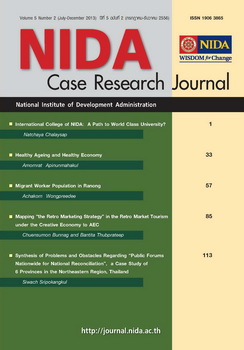International College of NIDA: A Path to World Class University?
Keywords:
World Class University, NIDA International College, SWOT Analysis, University AdministrationAbstract
After talking to Dr. Sombat Thamrongthanyawong, outgoing president of the National Institute of Development Administration, whose term would end on June 2, 2013, Dr. Piboon Puriveth, dean of the International College of NIDA (ICO-NIDA), was seated in his off ice, deep in thought. His face showed great concern about his college. Although founded at the end of December 2011, the ICO-NIDA admitted its f irst students for its graduate programs in August 2012; and, by February 2013, the number of students for the f irst of the trimesters (beginning in January 2013) had not increased satisfactorily. Established with the goal of attracting foreign and Thai students who wanted to attend an international graduate program, the ICO-NIDA was supposed to pay for itself. But, could the college pay for itself, given the current enrollment realities? As of February 27, 2013, his college had only around 30 students, all of whom were Thai nationals, except two students from China and the three German students expected to enroll later. A month earlier, the Master’s degree program in Management conducted in Chinese had to be terminated because only two Chinese had applied for the program.Dr. Piboon thought that around 100 students per year would be enough for his college to survive. He had advertised the ICO programs on the Internet in order to try to reach prospective students, thereby also keeping the public relations costs low. Would this outreach strategy, along with the recently implemented year-around admissions policy, bring in the target number of students? On the instructional side, he had signed memoranda of understanding (MOUs) with several overseas universities whose faculty would be invited as visiting professors to teach in ICO programs. But, would the new college earn enough money to defray the invitation costs? That was one thing. Another question was whether visiting professors would be able to come to Thailand whenever required. If not, how could he handle the instructional gaps that would ensue?
Many other questions also came to his mind: Were other schools at NIDA and at similar international colleges in other universities in Thailand and elsewhere in the ASEAN region offering similar programs competing for the same targeted group of students? If so, what could he do to insure that NIDA’s ICO would be fully able to hold its own against both present and potential future competition? These were some of the questions for which he had to f ind answers because if ICO-NIDA could not be made successful, then NIDA President Sombat’s hope for NIDA to become an international world class university might also fade.
Downloads
How to Cite
Chalaysap, N. (2014). International College of NIDA: A Path to World Class University?. NIDA Case Research Journal, 5(2), 1–32. retrieved from https://so04.tci-thaijo.org/index.php/NCRJ/article/view/27661
Issue
Section
Case Study





